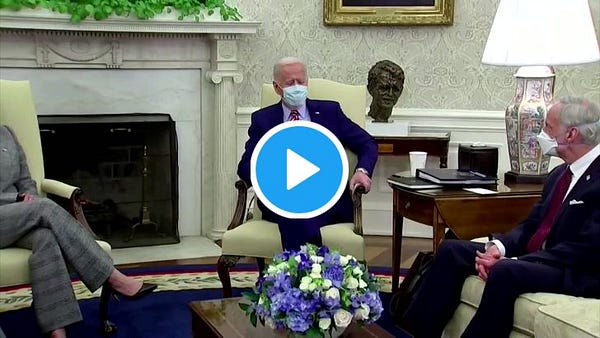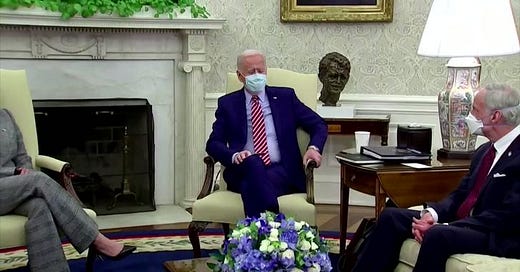I’ve got plenty of gripes with Biden, but I’ve been pleasantly surprised at his ability to do something progressives and the center left of the Democratic Party have inexplicably failed to do for years and years: use the specter of geopolitical competition as a means of pushing forward urgently needed spending bills on infrastructure, labor market reform, and other key parts of the agenda railroaded by the Republican Party for several decades now. Biden’s smartly seized the moment with what at first appears to be a fairly casual line in an interview, but is clearly a shot aimed at Washington’s China hawks, many of whom like holding up spending bills when they don’t benefit the military or rich asset owners who primarily earn off of capital gains.


Biden’s verbal tic on ‘eating our lunch’ has a history from his presidential campaign, one that suggests he’s evolved significantly over the last 18 months on how to best sell a bipartisan infrastructure bill that is otherwise separate from COVID stimulus and trap Republicans in the process. He quite literally said “China’s going to eat our lunch? Come on, man” at an event in early May 2019 dismissing the idea that China could overtake the United States on the world stage:
Campaigning against Trump probably made his team realize that best chance they have of making ket systemic investments — and campaigning on them — is using the threat of China and appeal simultaneously to the nation’s ego and the most staunch Republican hawks like Marco Rubio who shamelessly use every chance they can to railroad necessary spending elsewhere. What we’re seeing, finally, is the evolution of the artificial domestic/foreign policy divide in American politics vanish. The Global War on Terror never necessitated the same types of politicking because terrorist networks didn’t have their own states, let alone states that could compete with American structural power in any way, shape, or form. Russia could never provide that impetus because it was a useful boogeyman for ‘credibility’ — vague, nebulous, and generally a political tool to win arguments on policy matters that aren’t a core national interest — or else one to explain why Democrats lose elections they shouldn’t. No one in Washington was watching American manufacturing jobs or financial firms setup shop in Russia, and no was worried about an explosion of Russian economic growth after 2013. China’s a different story.
American businesses are responding to this shift and it’s also shifting the political context for policy lobbying in Washington in unexpected ways. Take the BDO Manufacturing CFO survey:
Over 1 in 5 US manufacturers are trying to find ways to relocate supply chains back in the US, nearly a quarter want to relocate supply chains — this is a wash since some of that would be into China to serve China’s market realistically, but in many cases probably means ASEAN — and just over half are investing into cost-cutting and efficiency gains assuming more shifts in trade policy. That’s actually huge. There’s a reason the Chamber of Commerce, long a Republican lobbying bastion, is changing its tack and a lot warmer to Biden than many expected. Trump’s presidency fundamentally shifted the consensus on how the US has to compete with China, and being ‘pro-business’ today means being able to bring more jobs back to the US or locate them in countries that aren’t a security risk. If you want to re-shore American jobs, then you’ve got to pay better wages, offer better benefits, and make structural investments into things like transport for work at the regional level to get US businesses going. There’s no way to fight spatial inequality in the US — something that may well change considerably as a result of working from home for a widening array of service industries — without enlisting business alongside the current policy pivot taking place.
The data shows that wealth inequality is striated at the regional level, and most clearly concentrated in the Northeast and the West. The following shows standard deviations for pre-tax income are highest in those parts of the country:
So the relative inequality of incomes may be lower elsewhere, but that’s also a reflection of a lack of opportunities and, for many counties, a loss of manufacturing jobs that permanently scarred towns. High income counties are increasingly concentrated across the country, but crucially, the fight over manufacturing is pretty obviously most salient for Midwestern states. The growing chorus of lobbies pursuing reshoring like Heartland Forward are going to be selling that fact — and Democrats’ need to retain the Rust Belt and flip Ohio back — when showing up with their presentations off of K Street or when they visit the Hill:
It also happens to matter a lot for Democrats in North Carolina and Georgia based on the presence of manufacturing jobs, as Iowa. You can see the political logic emerging based on the 2020 election map. I have very little faith the Democratic Party is particularly adept at exploiting these shifts, but Biden’s cracked the door open just as the landscape for the economic interests pushing on policy have actually tilted left (a bit). I’m watching to see how business reacts to the next round of announcements about an infrastructure bill and COVID stimulus to see if Biden’s and his team’s got the gumption to put their boot on the throat of the Republican Party using China. The jury’s out and there’s plenty of other extracurricular nonsense going on with the second impeachment trial. But they’ve created an opening and showed their hand, at least on the infrastructure front.
Like what you read? Pass it around to your friends! If anyone you know is a student or professor and is interested, hit me up at @ntrickett16 on Twitter or email me at nbtrickett@gmail.com and I’ll forward a link for an academic discount (edu accounts only!).






